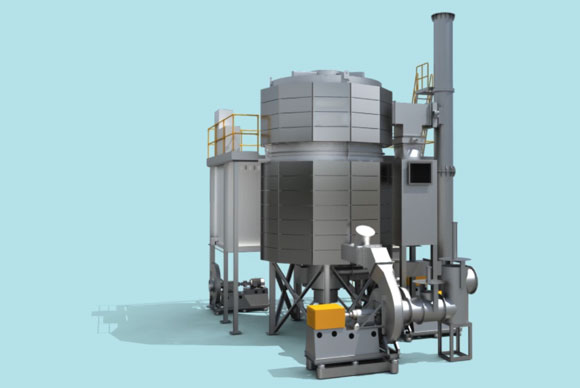What are the best practices for RTO gas treatment in the paint and coatings industry?
Gas treatment is a crucial aspect of the paint and coatings industry, ensuring compliance with environmental regulations and maintaining air quality standards. Regenerative Thermal Oxidizers (RTOs) are widely recognized as an effective solution for gas treatment in this industry. In this article, we will explore the best practices for RTO gas treatment in the paint and coatings industry, discussing key considerations and strategies for optimal performance.
1. Proper RTO Sizing
– Adequate sizing of an RTO system is vital for efficient gas treatment in the paint and coatings industry.
– Factors such as exhaust volume, composition, and flow rate should be carefully evaluated during the design phase.
– A well-sized RTO ensures optimal gas residence time and temperature control, maximizing the destruction of volatile organic compounds (VOCs).
2. Pre-Treatment Processes
– Implementing effective pre-treatment processes can significantly enhance the performance of RTO gas treatment systems.
– The removal of particulate matter and moisture from the gas stream reduces the risk of fouling and corrosion within the RTO unit.
– Pre-treatment techniques such as filtration, condensation, and separation should be employed to minimize the potential for system downtime and maintenance issues.
3. Optimal RTO Operating Parameters
– Operating an RTO within the recommended temperature and oxygen levels is essential for effective gas treatment.
– Maintaining the correct temperature range ensures efficient VOC destruction, while controlling the oxygen levels prevents the formation of hazardous byproducts.
– Regular monitoring and adjustment of these parameters are necessary to achieve optimal performance and compliance.
4. Heat Recovery Systems
– Incorporating heat recovery systems into RTO design can significantly improve energy efficiency.
– Heat exchangers capture and reuse the heat generated during the combustion process, reducing the overall energy consumption of the gas treatment system.
– This not only reduces operational costs but also contributes to the sustainability goals of the paint and coatings industry.
5. Monitoring and Maintenance
– Regular monitoring and maintenance of RTO gas treatment systems are vital for their long-term effectiveness.
– Continuous monitoring of gas flow, temperature, pressure, and pollutant levels allows for timely adjustments and proactive troubleshooting.
– Scheduled maintenance, including filter replacements, inspections, and cleaning, ensures the ongoing performance and reliability of the RTO system.
6. Operator Training and Awareness
– Proper training of operators involved in RTO gas treatment is crucial to ensure safe and efficient operation.
– Operators should be trained on system controls, maintenance procedures, and emergency protocols.
– Increasing operator awareness regarding the importance of gas treatment and its impact on the environment fosters a culture of compliance and responsible operation.
7. Regulatory Compliance
– Adhering to regulatory requirements is paramount in the paint and coatings industry.
– Regular monitoring, documentation, and reporting of gas treatment system performance are necessary to demonstrate compliance with environmental standards.
– Staying up to date with changing regulations and technological advancements helps optimize RTO gas treatment practices.
8. Continuous Improvement and Innovation
– The paint and coatings industry should constantly strive for continuous improvement and innovation in RTO gas treatment.
– Research and development efforts can lead to the introduction of new technologies and processes that enhance efficiency and reduce environmental impact.
– Collaboration among industry stakeholders fosters knowledge sharing and facilitates the adoption of best practices.
By following these best practices, the paint and coatings industry can establish effective RTO gas treatment systems that ensure compliance, protect the environment, and contribute to sustainable operations.
 We are a high-tech enterprise specializing in the comprehensive treatment of volatile organic compounds (VOCs) waste gas and carbon reduction and energy-saving technology for high-end equipment manufacturing. Our core technical team comes from the Aerospace Liquid Rocket Engine Research Institute (Aerospace Sixth Institute); it has more than 60 R&D technicians, including 3 senior engineers at the researcher level and 16 senior engineers. It has four core technologies: thermal energy, combustion, sealing, and automatic control; it has the ability to simulate temperature fields and air flow field simulation modeling and calculation; it has the ability to test the performance of ceramic thermal storage materials, the selection of molecular sieve adsorption materials, and the experimental testing of the high-temperature incineration and oxidation characteristics of VOCs organic matter. The company has built an RTO technology research and development center and an exhaust gas carbon reduction engineering technology center in the ancient city of Xi’an, and a 30,000m122 production base in Yangling. The production and sales volume of RTO equipment is far ahead in the world.
We are a high-tech enterprise specializing in the comprehensive treatment of volatile organic compounds (VOCs) waste gas and carbon reduction and energy-saving technology for high-end equipment manufacturing. Our core technical team comes from the Aerospace Liquid Rocket Engine Research Institute (Aerospace Sixth Institute); it has more than 60 R&D technicians, including 3 senior engineers at the researcher level and 16 senior engineers. It has four core technologies: thermal energy, combustion, sealing, and automatic control; it has the ability to simulate temperature fields and air flow field simulation modeling and calculation; it has the ability to test the performance of ceramic thermal storage materials, the selection of molecular sieve adsorption materials, and the experimental testing of the high-temperature incineration and oxidation characteristics of VOCs organic matter. The company has built an RTO technology research and development center and an exhaust gas carbon reduction engineering technology center in the ancient city of Xi’an, and a 30,000m122 production base in Yangling. The production and sales volume of RTO equipment is far ahead in the world.
¹«Ë¾¼òÒª½éÉÜ
ÎÒÃÇÊÇÒ»¼Ò¸ß¿Æ¼¼ÆóÒµ£¬×¨×¢ÓÚ»Ó·¢ÐÔÓлúÎï(VOCs)·ÏÆøµÄ×ÛºÏÖÎÀíºÍ̼¼õÅÅÓë½ÚÄܼ¼Êõ¡£ÎÒÃǵĺËÐļ¼ÊõÍŶÓÀ´×Ôº½¿ÕÒºÌå»ð¼ý·¢¶¯»úÑо¿Ëù(º½ÌìÁùÔº)£¬ÓµÓÐ60ÓàÃûÑз¢¼¼ÊõÈËÔ±£¬ÆäÖаüÀ¨3ÃûÑо¿Ô±¼¶¸ß¼¶¹¤³ÌʦºÍ16Ãû¸ß¼¶¹¤³Ìʦ¡£ÎÒÃÇÓµÓÐÈÈÄÜ¡¢È¼ÉÕ¡¢ÃÜ·âºÍ×Ô¶¯¿ØÖÆËÄ´óºËÐļ¼Êõ£»¾ß±¸Ä£Äâζȳ¡ºÍÆøÁ÷³¡·ÂÕ潨ģºÍ¼ÆËãµÄÄÜÁ¦£»¾ß±¸ÌÕ´ÉÐîÈȲÄÁÏÐÔÄܲâÊÔ¡¢·Ö×ÓɸÎü¸½²ÄÁÏÑ¡ÔñÒÔ¼°VOCsÓлúÎï¸ßηÙÉÕºÍÑõ»¯ÌØÐÔµÄʵÑé²âÊÔÄÜÁ¦¡£¹«Ë¾ÔÚÎ÷°²¹Å³Ç½¨Á¢ÁËRTO¼¼ÊõÑз¢ÖÐÐĺͷÏÆø̼¼õÅŹ¤³Ì¼¼ÊõÖÐÐÄ£¬²¢ÔÚÑîÁ轨Á¢ÁËÒ»¸ö30,000m2µÄÉú²ú»ùµØ¡£RTOÉ豸µÄ²úÏúÁ¿ÔÚÈ«Çò´¦ÓÚÁìÏȵØλ¡£
Ñз¢Æ½Ì¨
- ¸ßЧȼÉÕ¿ØÖƼ¼ÊõÊÔÑę́
- ·Ö×ÓɸÎü¸½Ð§ÄÜÊÔÑę́
- ¸ßЧÌÕ´ÉÐîÈȼ¼ÊõÊÔÑę́
- ³¬¸ßÎÂÓàÈÈ»ØÊÕÊÔÑę́
- Æø̬Á÷ÌåÃÜ·â¼¼ÊõÊÔÑę́
¸ÃÊÔÑę́¾ß±¸¸ßЧȼÉÕ¿ØÖƼ¼ÊõµÄÑз¢ºÍ²âÊÔÄÜÁ¦£¬¿É±£Ö¤·ÏÆø´¦ÀíÉ豸µÄ¸ßЧÐÔºÍÎȶ¨ÐÔ¡£
¸ÃÊÔÑę́¿É²âÊÔºÍÆÀ¹À·Ö×ÓɸÎü¸½²ÄÁϵÄÎü¸½Ð§ÄÜ£¬±£Ö¤·ÏÆø´¦ÀíÉ豸µÄÎü¸½Ð§¹û¡£
¸ÃÊÔÑę́¿É²âÊÔºÍÑз¢¸ßЧÌÕ´ÉÐîÈȲÄÁÏ£¬Ìá¸ß·ÏÆø´¦ÀíÉ豸µÄÄÜÁ¿»ØÊÕЧÂÊ¡£
¸ÃÊÔÑę́¿ÉÒÔ¶Ô³¬¸ßÎÂÓàÈÈ»ØÊÕ¼¼Êõ½øÐÐÑо¿ºÍ²âÊÔ£¬ÊµÏÖ·ÏÆø´¦ÀíÉ豸µÄÄÜÁ¿»ØÊÕºÍÔÙÀûÓá£
¸ÃÊÔÑę́¾ß±¸Æø̬Á÷ÌåÃÜ·â¼¼ÊõµÄÑз¢ºÍ²âÊÔÄÜÁ¦£¬È·±£·ÏÆø´¦ÀíÉ豸µÄ°²È«ºÍÎȶ¨¡£

רÀûÓëÈÙÓþ
ÎÒÃÇÔÚºËÐļ¼ÊõÉÏÉ걨ÁË68ÏîרÀû£¬ÆäÖаüÀ¨21Ïî·¢Ã÷רÀû£¬»ù±¾¸²¸ÇÁ˹ؼü²¿¼þ¡£ÒÑ»ñÊÚȨµÄרÀû°üÀ¨4Ïî·¢Ã÷רÀû¡¢41ÏîʵÓÃÐÂÐÍרÀû¡¢6ÏîÍâ¹ÛרÀûºÍ7ÏîÈí¼þÖø×÷Ȩ¡£

Éú²úÄÜÁ¦
- ¸Ö°å¡¢ÐͲÄ×Ô¶¯Å×ÍèÅçÆáÉú²úÏß
- ÊÖ¶¯Å×ÍèÉú²úÏß
- ³ý³¾»·±£É豸
- ×Ô¶¯ÅçÆá·¿
- ºæ¸É·¿
¸ÃÉú²úÏ߾߱¸¸Ö°åºÍÐͲĵÄ×Ô¶¯Å×ÍèÅçÆáÄÜÁ¦£¬±£Ö¤²úÆ·±íÃæµÄÖÊÁ¿ºÍÍ¿²ãµÄÕ³¸½Á¦¡£
ÊÖ¶¯Å×ÍèÉú²úÏß¿ÉÂú×ãÌØÊâ²úÆ·µÄÅ×ÍèÐèÇ󣬱£Ö¤²úÆ·±íÃæµÄÇå½à¶ÈºÍÖÊÁ¿¡£
ÎÒÃÇÉú²úµÄ³ý³¾»·±£É豸¿ÉÒÔÓÐЧ¾»»¯·ÏÆø£¬±£»¤»·¾³ºÍÈËÀཡ¿µ¡£
×Ô¶¯ÅçÆá·¿¾ß±¸×Ô¶¯»¯ÅçÆáÉ豸ºÍ»·¾³¿ØÖÆϵͳ£¬±£Ö¤²úÆ·ÅçÆáÖÊÁ¿ºÍÉú²úЧÂÊ¡£
ÎÒÃǵĺæ¸É·¿¾ß±¸ÏȽøµÄºæ¸ÉÉ豸ºÍÎÂʪ¶È¿ØÖÆϵͳ£¬¿ÉÂú×ã¸÷ÖÖ²úÆ·µÄºæ¸ÉÐèÇó¡£

ÎÒÃǺôÓõ¿Í»§ÓëÎÒÃǺÏ×÷£¬ÒòΪÎÒÃÇÓÐÒÔÏÂÓÅÊÆ£º
- ·á¸»µÄÑз¢¾ÑéºÍ¼¼ÊõʵÁ¦
- ÁìÏȵĺËÐļ¼ÊõºÍרÀû±£»¤
- ÏȽøµÄÉú²úÉ豸ºÍÉú²úÄÜÁ¦
- ¸ßЧµÄ·ÏÆø´¦ÀíºÍ̼¼õÅŽâ¾ö·½°¸
- È«ÃæµÄÊÛºó·þÎñºÍ¼¼ÊõÖ§³Ö
- »ý¼«ÏìÓ¦»·±£Õþ²ß£¬Ìṩ¿É³ÖÐø·¢Õ¹½â¾ö·½°¸

Autor: Miya
